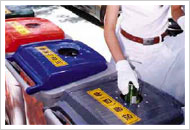Purchasing Garbage Bags
In cities, regulation garbage bags may be purchased at supermarkets or convenience stores in your neighborhood. In rural areas they may be purchased at the local government offices or through the local women's association (bunyeohoe). There are generally six or seven sizes; 2, 5, 10, 20, 50, and 100 liters. Prices vary according to size.
Disposal Procedures
1) Common Garbage

Use regulation bags and place outside. Ask the building owner or a neighbor where to place them if you are unsure. If you don't use regulation bags, your garbage will not be collected.
2) Food Waste
Remove all moisture and anything that cannot be eaten by livestock, then use a regulation bag for disposal. In areas where there are collection boxes dedicated for food waste disposal, you do not need to use regulation bags. Food waste produced by families and restaurants have high moisture levels, making incineration difficult, and it still secretes harmful substances after arriving at the landfill, which in turn pollutes water resources.
3) Recyclable Items
Materials that are recyclable such as plastic, cans, bottles, and paper should be put in a clear plastic bag or even in a sandbag-like bag and put in the appropriate spot on collection day. Spray cans, cooking-gas cans, and other such things can explode, so put a hole in these to make sure they are completely empty.
4) Large Waste Objects
Televisions, washing machines, and other home electronics and large items [of garbage] that cannot be placed in bags should be placed in the collection spot after attaching a sticker purchased at your local dong Community Service Center or where you purchase your regulation bags.
| Type | Item | Recyclable | Non-recyclable |
|---|---|---|---|
| Paper | Newspaper | - Dispose of stacked flat and tied together. - Plastic-coated advertisements, other non-paper materials must not be mixed. |
- Plastic-coated advertisement inserts - Wet newspaper |
| Pamphlets, shopping bags |
- Remove plastic coating, springs, etc.br/>- Plastic wrappings do not qualify. | - Book springs - Plastic coatings, fax paper |
|
| Paper cups, milk cartons |
- Empty contents, rinse with water,then flatten and put in bag or tie together. | ||
| Packing boxes, etc |
- Remove tape, staples, or other such material,then flatten to make for easy transportation. | - Candy wrappers - plastic, tape |
|
| Metal | Steel and Steel and aluminum |
- Empty, rinse, and flatten as possible. | |
| Butane gas cans, insect killing sprays |
- Puncture to empty and remove danger of explosion | ||
| Old metal, nonferrous metals |
- Place in bag or tie together to assure no mixture with foreign materials | ||
| Paper | Beverage bottles, etc. |
- Remove cap, empty, rinse with water. ※ Beer and soju can be sold back to your market. |
- Bottles containing cosmetics. |
| Plastics | PET bottles | - Remove cap, empty, rinse with water. | - Waste oils. |
| Synthetic resin containers |
- Attempt to flatten to minimize size. | ||
| Styrofoam | Packaging material for home electronics |
- Remove other material, stickers,and place in bag or tie together.lunches, fruit containers, etc. | - Smooth surface styrofoam, ex. used for ramen bowls, take-out |
| Fruit packaging containers |
- Styrofoam from fish and fruit boxes should be disposed of after clean of other substances. | - styrofoam for construction use etc. | |
| Clothing | Outer garment | - Dispose of neatly in plastic bag after washing, be sure to keep from becoming wet. | - cashmere, bedding |
